Tai languages
The Tai or Zhuang–Tai[2] languages (Thai: ภาษาไท or ภาษาไต, transliteration: p̣hās̛̄āthay or p̣hās̛̄ātay), are a branch of the Kra–Dai language family. The Tai languages include the most widely spoken of the Tai–Kadai languages, including Standard Thai or Siamese, the national language of Thailand; Lao or Laotian, the national language of Laos; Myanmar's Shan language; and Zhuang, a major language in the Southern Chinese province of Guangxi.
| Tai | |
|---|---|
| Zhuang–Thai | |
| Geographic distribution | Southern China (esp. Guangxi, Guizhou, Yunnan and Guangdong), Southeast Asia, historically in India (Assam) |
| Linguistic classification | Kra–Dai
|
| Proto-language | Proto-Tai |
| Subdivisions |
|
| ISO 639-2 / 5 | tai |
| Glottolog | daic1237[1] |
 Distribution of Tai languages:
Northern Tai / Northern Zhuang
Central Tai / Southern Zhuang
Southwestern Tai / Thai | |
Name
Cognates with the name Tai (Thai, Dai, etc.) are used by speakers of many Tai languages. The term Tai is now well-established as the generic name in English. In his book The Tai-Kadai Languages Anthony Diller claims that Lao scholars he has met are not pleased with Lao being regarded as a Tai language.[3] For some, Thai should instead be considered a member of the Lao language family.[3] One or more Ancient Chinese characters for 'Lao' may be cited in support of this alternative appellation.[3] Some scholars including Benedict (1975), have used Thai to refer to a wider (Tai) grouping and one sees designations like proto-Thai and Austro-Thai in earlier works.[3] In the institutional context in Thailand, and occasionally elsewhere, sometimes Tai (and its corresponding Thai-script spelling, without a final -y symbol) is used to indicate varieties in the language family not spoken in Thailand or spoken there only as the result of recent immigration.[3] In this usage Thai would not then be considered a Tai language.[3] On the other hand, Gedney, Li and others have preferred to call the standard language of Thailand Siamese rather than Thai, perhaps to reduce potential Thai/Tai confusion, especially among English speakers not comfortable with making a non-English initial unaspirated voiceless initial sound for Tai, which in any event might sound artificial or arcane to outsiders.
According to Michel Ferlus, the ethnonyms Tai/Thai (or Tay/Thay) would have evolved from the etymon *k(ə)ri: 'human being' through the following chain: kəri: > kəli: > kədi:/kədaj (-l- > -d- shift in tense sesquisyllables and probable diphthongization of -i: > -aj).[4][5] This in turn changed to di:/daj (presyllabic truncation and probable diphthongization -i: > -aj). And then to *dajA (Proto-Southwestern Tai) > tʰajA2 (in Siamese and Lao) or > tajA2 (in the other Southwestern and Central Tai languages by Li Fangkuei). Michel Ferlus' work is based on some simple rules of phonetic change observable in the Sinosphere and studied for the most part by William H. Baxter (1992).[5]
Many of the languages are called Zhuang in China and Nung in Vietnam.
History
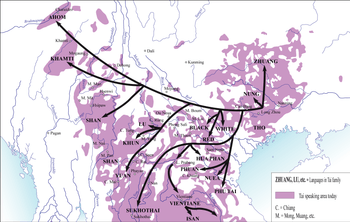
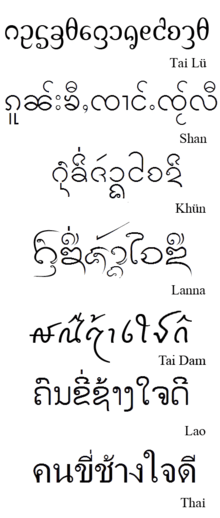
Citing the fact that both the Zhuang and Thai peoples have the same exonym for the Vietnamese, kɛɛuA1,[6] Jerold A. Edmondson of the University of Texas at Arlington posited that the split between Zhuang (a Central Tai language) and the Southwestern Tai languages happened no earlier than the founding of Jiaozhi in Vietnam in 112 BCE but no later than the 5th-6th century AD.[7] Based on layers of Chinese loanwords in Proto-Southwestern Tai and other historical evidence, Pittayawat Pittayaporn (2014) suggests that the dispersal of Southwestern Tai must have begun sometime between the 8th and 10th centuries AD.[8]
Internal classification
Haudricourt (1956)
Haudricourt[9] emphasizes the specificity of Dioi (Zhuang) and proposes to make a two-way distinction between the following two sets. The original language names used in Haudricourt's (1956) are provided first; alternative names are given in parentheses.
| Tai |
| ||||||
Characteristics of the Dioi group pointed out by Haudricourt are (i) a correspondence between r- in Dioi and the lateral l- in the other Tai languages, (ii) divergent characteristics of the vowel systems of the Dioi group: e.g. 'tail' has a /a/ vowel in Tai proper, as against /ə̄/ in Bo-ai, /iə/ in Tianzhou, and /ɯə/ in Tianzhou and Wuming, and (iii) the lack, in the Dioi group, of aspirated stops and affricates, which are found everywhere in Tai proper.
As compared with Li Fang-kuei's classification, Haudricourt's classification amounts to consider Li's Southern Tai and Central Tai as forming a subgroup, of which Southwestern Tai is a sister: the three last languages in Haudricourt's list of 'Tai proper' languages are Tho (Tày), Longzhou, and Nung, which Li classifies as 'Central Tai'.
| Tai |
| ||||||||||||
Li (1977)
Li Fang-Kuei divided Tai into Northern, Central, and Southwestern (Thai) branches. However, Central Tai does not appear to be a valid group. Li (1977) proposes a tripartite division of Tai into three sister branches. This classification scheme has long been accepted as the standard one in the field of comparative Tai linguistics.
| Tai |
| |||||||||
Gedney (1989)
Gedney (1989) considers Central and Southwestern Tai to form a subgroup, of which Northern Tai is a sister. This classification is in agreement with Haudricourt (1956).
| Tai |
| ||||||||||||
Luo (1997)
Luo Yongxian (1997:232)[10] classifies the Tai languages as follows, and proposes a fourth branch called Northwestern Tai that includes Ahom, Shan, Dehong Dai, and Khamti. All branches are considered to be coordinate to each other.
| Tai |
| ||||||||||||
Pittayaporn (2009)
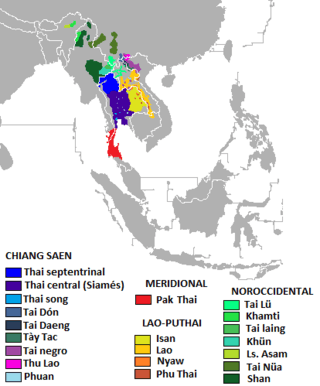
Overview
Pittayawat Pittayaporn (2009) classifies the Tai languages based on clusters of shared innovations (which, individually, may be associated with more than one branch) (Pittayaporn 2009:298). In Pittayaporn's preliminary classification system of the Tai languages, Central Tai is considered to be paraphyletic and is split up into multiple branches, with the Zhuang varieties of Chongzuo in southwestern Guangxi (especially in the Zuo River valley at the border to Vietnam) having the most internal diversity. The Southwestern Tai and Northern Tai branches remain intact as in Li Fang-Kuei's 1977 classification system, and several of the Southern Zhuang languages allocated ISO codes are considered to be paraphyletic. The classification is as follows.[11]
| Tai |
| ||||||||||||||||||||||||||||||||||||||||||||||||||||||
Standard Zhuang is based on the dialect of Shuangqiao (双桥), Wuming District.
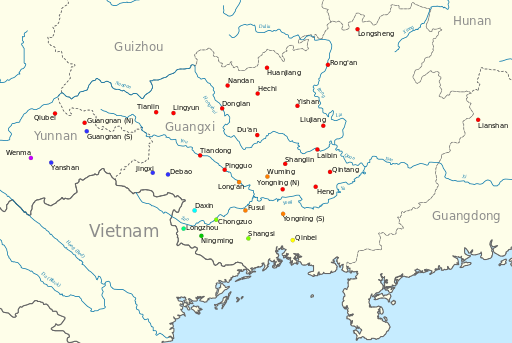
Sound changes
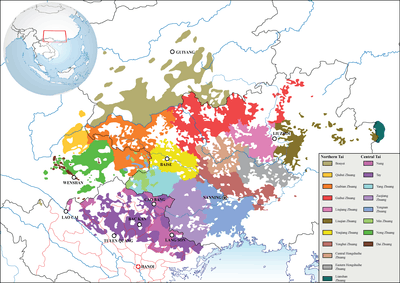
The following phonological shifts occurred in the Q (Southwestern), N (Northern), B (Ningming), and C (Chongzuo) subgroups (Pittayaporn 2009:300–301).
| Proto-Tai | Subgroup Q[12] | Subgroup N[13] | Subgroup B | Subgroup C |
|---|---|---|---|---|
| *ɤj, *ɤw, *ɤɰ | *aj, *aw, *aɰ | *i:, *u:, *ɯ: | *i:, *u:, *ɯ: | – |
| *ɯj, *ɯw | *iː, *uː[14] | *aj, *aw[15] | *iː, *uː | – |
| *we, *wo | *eː, *oː | *iː, *uː | *eː, *oː[16] | *eː, *oː[17] |
| *ɟm̩.r- | *br- | *ɟr- | – | *ɟr- |
| *k.t- | – | *tr- | – | *tr- |
| *ɤn, *ɤt, *ɤc | – | *an, *at, *ac[18] | – | – |
Furthermore, the following shifts occurred at various nodes leading up to node Q.
- E: *p.t- > *p.r-; *ɯm > *ɤm
- G: *k.r- > *qr-
- K: *eː, *oː > *ɛː, *ɔː
- O: *ɤn > *on
- Q: *kr- > *ʰr-
Edmondson (2013)
Jerold A. Edmondson's (2013)[19] computational phylogenetic analysis of the Tai languages is shown below. Tay and Nung are both shown to be coherent branches under Central Tai. Northern Tai and Southwestern Tai are also shown to be coherent branches.
| Tai |
| |||||||||||||||||||||
Reconstruction
Proto-Tai has been reconstructed in 1977 by Li Fang-Kuei and by Pittayawat Pittayaporn in 2009.[20]
Proto-Southwestern Tai has also been reconstructed in 1977 by Li Fang-Kuei and by Nanna L. Jonsson in 1991.[21]
| Proto-Tai | Thai alphabet | ||
| 1st | singular | *ku | กู |
| dual (exclusive) | *pʰɯa | เผือ | |
| plural (exclusive) | *tu | ตู | |
| Incl. | dual (inclusive) | *ra | รา |
| plural (inclusive) | *rau | เรา | |
| 2nd | singular | *mɯŋ | มึง |
| dual | *kʰɯa | เขือ | |
| plural | *su | สู | |
| 3rd | singular | *man | มัน |
| dual | *kʰa | ขา | |
| plural | *kʰau | เขา |
Comparison
Below is comparative table of Tai languages.
| English | Proto-Southwestern Tai[22] | Thai | Lao | Northern Thai | Shan | Tai Lü | Standard Zhuang | Ahom |
|---|---|---|---|---|---|---|---|---|
| wind | *lom | /lōm/ | /lóm/ | /lōm/ | /lóm/ | /lôm/ | /ɣum˧˩/ | lum |
| town | *mɯaŋ | /mɯ̄aŋ/ | /mɯ́aŋ/ | /mɯ̄aŋ/ | /mɤ́ŋ/ | /mɤ̂ŋ/ | /mɯŋ˧/ | mvng |
| earth | *ʔdin | /dīn/ | /dìn/ | /dīn/ | /lǐn/ | /dín/ | /dei˧/ | nin |
| fire | *vai/aɯ | /fāj/ | /fáj/ | /fāj/ | /pʰáj/ or /fáj/ | /fâj/ | /fei˧˩/ | phai |
| heart | *čai/aɯ | /hǔa tɕāj/ | /hǔa tɕàj/ | /hǔa tɕǎj/ | /hǒ tsǎɰ/ | /hó tɕáj/ | /sim/ | chau |
| love | *rak | /rák/ | /hāk/ | /hák/ | /hâk/ | /hak/ | /gyai˧˩/ | rak |
| water | *naam | /náːm/ | /nâm/ | /nám/ | /nâm/ | /nà̄m/ | /ɣaem˦˨/ | nam |
Writing systems
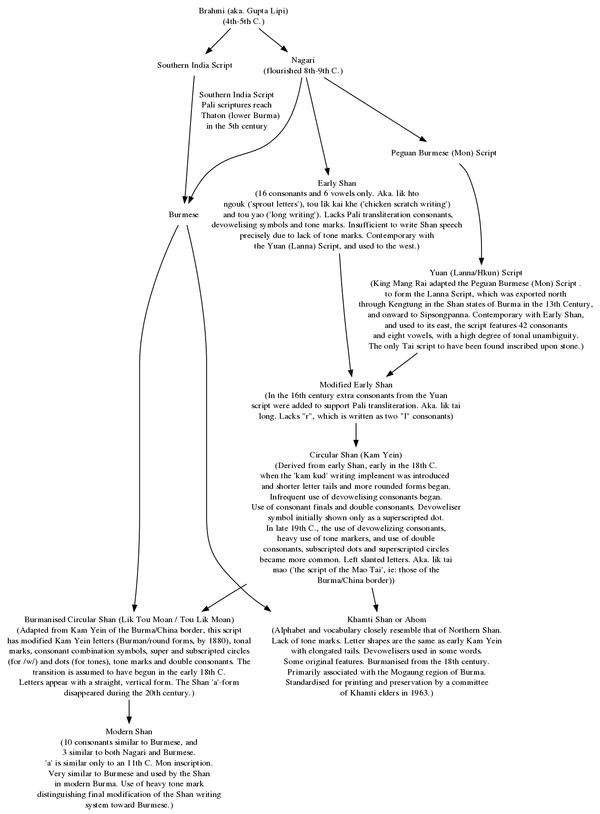
Many Southwestern Tai languages are written using Brahmi-derived alphabets. Zhuang languages are traditionally written with Chinese characters called Sawndip, and now officially written with a romanized alphabet, though the traditional writing system is still in use to this day.
- Thai alphabet
- Lao alphabet
- Sawndip
- Shan alphabet
- Ahom alphabet
- Tai Viet script
- Tai Le alphabet
- New Tai Lue alphabet
- Tai Tham alphabet
See also
- Miscellaneous Tai languages
- Zomia (region)
References
- Hammarström, Harald; Forkel, Robert; Haspelmath, Martin, eds. (2017). "Daic". Glottolog 3.0. Jena, Germany: Max Planck Institute for the Science of Human History.
- Diller, 2008. The Tai–Kadai Languages.
- Diller, Anthony; Edmondson, Jerry; Luo, Yongxian (2004). The Tai-Kadai Languages. Routledge (2004), pp. 5-6. ISBN 1135791163.
- Ferlus, Michel (2009). Formation of Ethnonyms in Southeast Asia. 42nd International Conference on Sino-Tibetan Languages and Linguistics, Nov 2009, Chiang Mai, Thailand. 2009, p.3.
- Pain, Frédéric (2008). An Introduction to Thai Ethnonymy: Examples from Shan and Northern Thai. Journal of the American Oriental Society Vol. 128, No. 4 (Oct. - Dec., 2008), p.646.
- A1 designates a tone.
- Edmondson, Jerold A. The power of language over the past: Tai settlement and Tai linguistics in southern China and northern Vietnam. Studies in Southeast Asian languages and linguistics, Jimmy G. Harris, Somsonge Burusphat and James E. Harris, ed. Bangkok, Thailand: Ek Phim Thai Co. Ltd. http://ling.uta.edu/~jerry/pol.pdf (see page 15)
- Pittayaporn, Pittayawat (2014). Layers of Chinese Loanwords in Proto-Southwestern Tai as Evidence for the Dating of the Spread of Southwestern Tai. MANUSYA: Journal of Humanities, Special Issue No 20: 47–64.
- Haudricourt, André-Georges. 1956. De la restitution des initiales dans les langues monosyllabiques : le problème du thai commun. Bulletin de la Société de Linguistique de Paris 52. 307–322.
- Luo, Yongxian. (1997). The subgroup structure of the Tai Languages: a historical-comparative study. Journal of Chinese Linguistics Monograph Series, (12), I-367.
- Pittayaporn, Pittayawat. 2009. The Phonology of Proto-Tai. PhD dissertation. Department of Linguistics, Cornell University.
- Unless indicated otherwise, all phonological shifts occurred at the primary level (node A).
- Unless indicated otherwise, all phonological shifts occurred at the primary level (node D).
- Also, the *ɯːk > *uːk shift occurred at node A.
- Innovation at node N
- For node B, the affected Proto-Tai syllable was *weː, *woː.
- For node C, the affected Proto-Tai syllable was *weː, *woː.
- Innovation at node J
- Edmondson, Jerold A. 2013. Tai subgrouping using phylogenetic estimation. Presented at the 46th International Conference on Sino-Tibetan Languages and Linguistics (ICSTLL 46), Dartmouth College, Hanover, New Hampshire, United States, August 7–10, 2013 (Session: Tai-Kadai Workshop).
- Jonsson, Nanna L. (1991) Proto Southwestern Tai. PhD dissertation, available from UMI and SEAlang.net on http://sealang.net/crcl/proto/
- http://language.psy.auckland.ac.nz/austronesian/language.php?id=684
- Thai Lexicography Resources
Further reading
- Brown, J. Marvin. From Ancient Thai to Modern Dialects. Bangkok: Social Science Association Press of Thailand, 1965.
- Chamberlain, James R. A New Look at the Classification of the Tai Languages. [s.l: s.n, 1972.
- Conference on Tai Phonetics and Phonology, Jimmy G. Harris, and Richard B. Noss. Tai Phonetics and Phonology. [Bangkok: Central Institute of English Language, Office of State Universities, Faculty of Science, Mahidol University, 1972.
- Diffloth, Gérard. An Appraisal of Benedict's Views on Austroasiatic and Austro-Thai Relations. Kyoto: Center for Southeast Asian Studies, Kyoto University, 1976.
- Đoàn, Thiện Thuật. Tay-Nung Language in the North Vietnam. [Tokyo?]: Instttute [sic] for the Study of Languages and Cultures of Asia and Africa, Tokyo University of Foreign Studies, 1996.
- Gedney, William J. On the Thai Evidence for Austro-Thai. [S.l: s.n, 1976.
- Gedney, William J., and Robert J. Bickner. Selected Papers on Comparative Tai Studies. Michigan papers on South and Southeast Asia, no. 29. Ann Arbor, Mich., USA: Center for South and Southeast Asian Studies, University of Michigan, 1989. ISBN 0-89148-037-4
- Gedney, William J., Carol J. Compton, and John F. Hartmann. Papers on Tai Languages, Linguistics, and Literatures: In Honor of William J. Gedney on His 77th Birthday. Monograph series on Southeast Asia. [De Kalb]: Northern Illinois University, Center for Southeast Asian Studies, 1992. ISBN 1-877979-16-3
- Gedney, William J., and Thomas J. Hudak. (1995). William J. Gedney's central Tai dialects: glossaries, texts, and translations. Michigan papers on South and Southeast Asia, no. 43. Ann Arbor, Mich: Center for South and Southeast Asian Studies, University of Michigan ISBN 0-89148-075-7
- Gedney, William J., and Thomas J. Hudak. William J. Gedney's the Yay Language: Glossary, Texts, and Translations. Michigan papers on South and Southeast Asia, no. 38. Ann Arbor, Mich: Center for South and Southeast Asian Studies, University of Michigan, 1991. ISBN 0-89148-066-8
- Gedney, William J., and Thomas J. Hudak. William J. Gedney's Southwestern Tai Dialects: Glossaries, Texts and Translations. Michigan papers on South and Southeast Asia, no. 42. [Ann Arbor, Mich.]: Center for South and Southeast Asian Studies, University of Michigan, 1994. ISBN 0-89148-074-9
- Hudak, Thomas John. William J. Gedney's The Tai Dialect of Lungming: Glossary, Texts, and Translations. Michigan papers on South and Southeast Asia, no. 39. [Ann Arbor]: Center for South and Southeast Asian Studies, University of Michigan, 1991. ISBN 0-89148-067-6
- Li, Fang-kuei. 1977. Handbook of Comparative Tai. Honolulu, Hawaii: University of Hawaiʼi Press.
- Li, Fang-kuei. The Tai Dialect of Lungchow; Texts, Translations, and Glossary. Shanghai: Commercial Press, 1940.
- Østmoe, Arne. A Germanic–Tai Linguistic Puzzle. Sino-Platonic papers, no. 64. Philadelphia, PA, USA: Dept. of Asian and Middle Eastern Studies, University of Pennsylvania, 1995.
- Sathāban Sūn Phāsā Qangkrit. Bibliography of Tai Language Studies. [Bangkok]: Indigenous Languages of Thailand Research Project, Central Institute of English Language, Office of State Universities, 1977.
- Shorto, H. L. Bibliographies of Mon–Khmer and Tai Linguistics. London oriental bibliographies, v. 2. London: Oxford University Press, 1963.
- Tingsabadh, Kalaya and Arthur S. Abramson. Essays in Tai Linguistics. Bangkok: Chulalongkorn University Press, 2001. ISBN 974-347-222-3